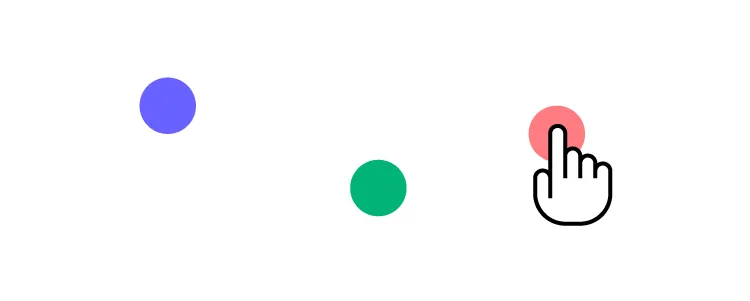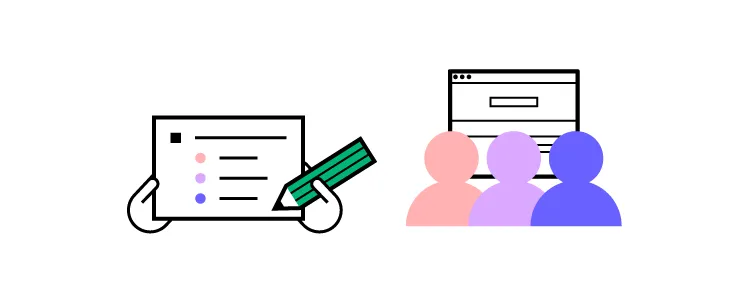UX Research Cheat Sheet
UX research is the bedrock for any design project. UX designers and researchers must gather insights about the market, competitors, and, most importantly, users.
This research continues throughout the design process as designers test ideas and gather feedback from participants and stakeholders. To be a good UX designer, you must be inquisitive and an active listener to truly understand your market and user needs.
In this UX research cheat sheet, we explore the research designers conduct at various stages of the design process and methods to gather and analyze data.
Table of Contents
Get meaningful user testing and stakeholder feedback with code-based high-fidelity prototypes from UXPin. Sign up for a free trial and discover how UXPin can enhance your product’s user experience.
What can you Gain With UX Research?
Here are some of the primary benefits of UX research:
- Eliminates bias and assumptions to help teams develop objective product designs that meet user needs
- Allows you to create human-centered strategies and goals for your products
- Provides insight into your users’ behavioral and usage patterns
- Reduces the costs associated with inaccurate designs and strategies
- Helps develop a long-term vision for the product roadmap
- Provides data for stakeholders to support design decisions and secure resources
Research in the Design Process

UX teams conduct research and test through the design process. These research methods change with each phase:
- Discover: Empathize and define
- Explore: Ideate and prototype
- Test: Test
- Monitor: Post-implementation
Let’s look a look at each of these in greater detail.
Discover
Discovery research happens at the beginning of the design thinking process. This early research is called the empathize phase because UX designers must put themselves into the shoes of their users to see the world from their perspective.
Typical research methods during the discovery phase include:
- Field research: Observing people in the environment where they use your product
- User interviews: One-on-one interviews to understand users’ problems
- Stakeholder interviews: Understand business needs and constraints
- Diary studies: Users document using your product over a period
- Internal research: Meetings with sales, marketing, support, etc. to gather insights from other teams
- Review analytics: User analytics and heatmaps (if you’re designing for an existing product)
- Usability heuristics: A set of ten principles from the Nielsen Norman Group used during a UX audit to evaluate a product’s usability
During discovery, UX designers must use this research to define user problems your product can solve. This research includes:
- Competitive analysis: Identify competitor strengths and weaknesses and determine what their customers like and dislike about the products
- User journey mapping: A visualization of how customers interact with your product
- Empathy map: Identifies what users see, hear, think, and feel as they complete tasks or a user journey
- User personas: A fictional character that represents a user demographic
Explore
Once UX designers have gathered and analyzed research, they ideate and prototype to solve users’ problems. Some explore research methods include:
- Brainstorming: Use research to develop design ideas and solutions–typically a collaborative effort using a whiteboard and sticky notes.
- Design: UX designers create sketches, wireframes, mockups, and other visuals to develop ideas for users’ problems.
- Card sorting: Participants sort cards into categories they find relevant. These categories help UX designers build information architecture and structure page layouts.
- Prototyping: Designers prototype throughout the design process, starting with low-fidelity paper prototypes to high-fidelity prototypes representing the final product.
- Stakeholder feedback: Presenting user research and prototypes to stakeholders for feedback.
Test
Testing is a vital research tool that enables designers to validate ideas developed during ideation. While testing appears to be a separate step, UX designers conduct tests throughout the design process, particularly while ideating and prototyping. Some of these methods include:
- Usability testing: Moderated and unmoderated tests with end-users on wireframes, mockups, information architecture, and prototypes.
- Accessibility testing: UX designers must test prototypes and UIs against accessibility guidelines and users with disabilities.
- Benchmark testing: Designers use benchmark tests to measure the success of product redesigns and upgrades.
- Surveys: A quick research method for testing large groups of users with questionnaires.
Monitor
After a release, researchers must monitor the product and users to identify bottlenecks and pain points. The monitoring phase adopts many of the same tests and techniques UX designers use during discovery. Research methods include:
- Product analytics: Researchers gather data to measure the releases’ impact on analytics like conversions, sales, funnel drop-offs, navigation, and more.
- Support data: Researchers can use customer support data to determine if a design solution reduces tickets for the issues they were trying to solve.
- User feedback: Aside from support tickets, UX designers must make it easy for users to comment, report issues, and ask questions. User feedback is particularly important for enterprise products where users rely on these tools for work.
- A/B testing: A/B testing is a common research method to measure the difference between two design ideas. It’s also helpful for measuring subtle differences, like a red vs. blue CTA button.
- Heat maps and screen recordings: Give researchers insights into how users navigate web pages. This data is essential for determining page layouts and hierarchy.
- Beta testing: An early product release, often to a select group of users. Researchers often combine beta testing with dairy studies to get as much meaningful feedback as possible before the official release.
- Search log analysis: A product’s search log can reveal a lot about user behavior which can help UX designers restructure layouts so popular items are easier to locate.
- Business assessment: Aside from user research, UX designers must evaluate a product’s business value performance. This information is important for stakeholder feedback and securing funding for future projects.
Quantitative vs. Qualitative UX Research Methods

UX research involves a mix of qualitative and quantitative testing:
- Quantitative: Tangible metrics and data
- Qualitative: Behavioral observations, opinions, motivations, and emotions
Quantitative data is measurable, while qualitative data is subjective and open to interpretation. When combined, these two metrics can put research into perspective.
For example, you notice a drop-off in conversions when you redesign an eCommerce checkout flow. The quantitative data tells you conversions fell from 5% to 4%. From user interviews, you learn that the new shipping methods are confusing. The qualitative data reveals what’s affecting conversions.
What Does the Research Process Look Like?
The research process will vary depending on the method, but there are several vital steps UX designers follow:
- Hypothesis: Many UX studies start with an idea researchers want to validate. For example, “we will make it easier for customers to find products and increase conversions if we put our best sellers on the home page.”
- Planning & preparation: A UX research plan defines objectives, determines the correct methodology, the research location, and the information researchers need to gather.
- Conducting research: Researchers conduct tests or research according to the plan.
- Compiling & analyzing results: Researchers must organize data to find patterns and opportunities. They might also have to present these findings to stakeholders for further analysis.
- Take action: Finally, UX researchers must use their results to determine the next course of action.
Improve Usability Testing With UXPin

UX designers rely on accurate user testing results. But most design tools lack the fidelity and functionality necessary to get meaningful feedback and test user experiences effectively.
UXPin is a code-based tool. So, designers can create code-like prototypes to provide usability participants and stakeholders with an accurate product experience.
Let’s explore a few of UXPin’s advanced prototyping features.
Variables
Most design tools display a graphical representation of an input field. In UXPin, input fields work just like they would in the final product. Variables allow you to capture user inputs and use that data elsewhere in the application–like a custom welcome message or populating a profile page.
States
You can create multiple States for any component in UXPin with different properties for each one. From standard button states to accordions and complex navigational menus.
Interactions
Interaction design is crucial for usability and product experience. UI designers can choose from an expansive list of triggers, actions, and animations to bring your prototypes to life.
UXPin takes things one step further than other design tools with Conditional Interactions, which allow you to create code-like “if-then” and “if-else” conditions which designers can use to validate an email or password. When combined with Variables, you can simulate a sign-up and login process–the possibilities are endless.
Expressions
Expressions give UXPin prototypes code-like functionality where designers can simulate form validation, build a functional shopping cart, validate credit cards, and more.
Accessibility
UX designers must always check user interfaces to ensure they pass accessibility standards. UXPin offers built-in accessibility tools to streamline testing with a Contrast Checker and Color Blindness Simulator.
Real Content & Data
How many times have you searched “lorem ipsum” for dummy copy or scanned Unsplash for the perfect image? UXPin’s built-in content generator allows you to populate UIs with relevant content like names, dates, numbers, addresses, and more. You can even match content by layer name where UXPin auto-populates data according to naming conventions.
UXPin also allows you to use your own data from Google Sheets, CSV, or JSON, to give users and stakeholders an authentic product experience.
Improve your UX research and testing with the world’s most advanced code-based design tool. Sign up for a free trial to experience the power and versatility of UXPin.

